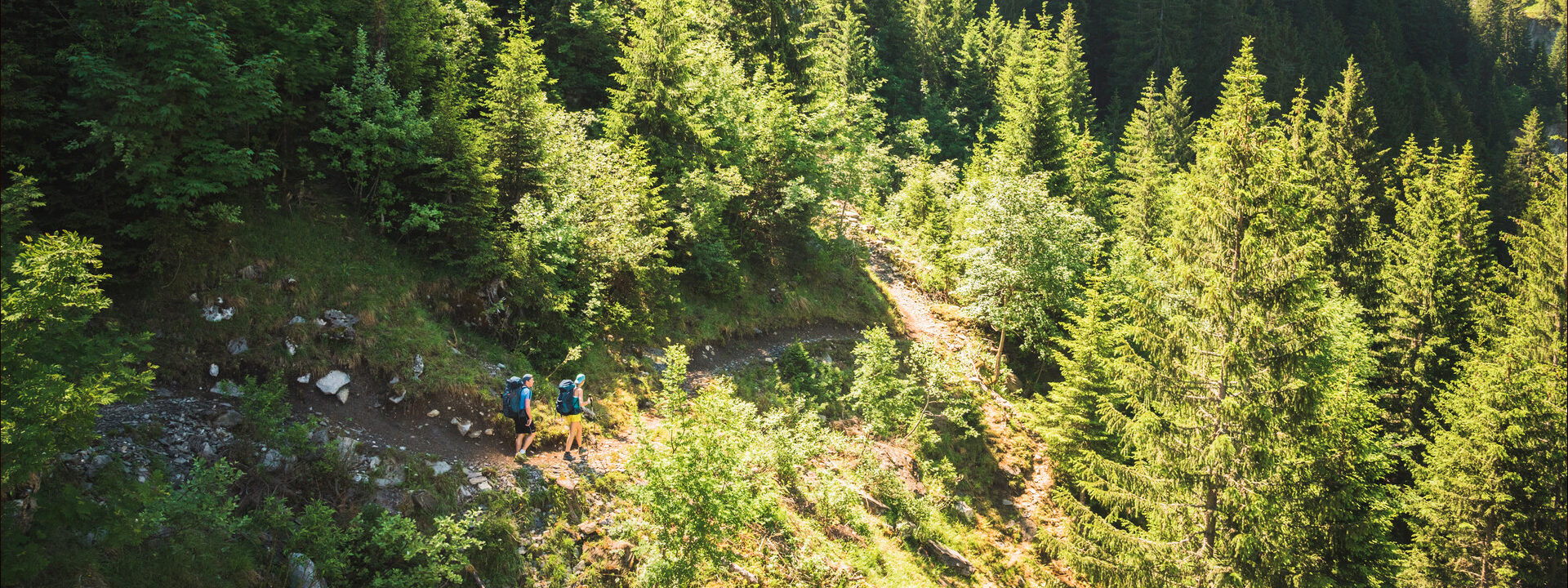Bursting with lush beauty and blessed with ideal climatic conditions, the Illiez Valley forests provide captivating landscapes that enchant locals and visitors alike. Stretching from the foothills of the Rhone Plain at an altitude of 450 meters up to the base of the Dents du Midi at around 2,000 meters, verdant layers of vegetation succeed each other in perfect harmony, respecting the preferred habitats of a multitude of different species.
The Dents du Midi massif acts as a natural atmospheric barrier, collecting every moisture-laden cloud that comes our way. As the clouds stack up and cover the entire valley, we can experience severe weather that challenges our infrastructure, but this is also what gives us our abundant vegetation and fertile land. The porous layers of sedimentary rock act like a sponge, storing vast amounts of water.
It’s interesting to note that the Illiez Valley got its name from a phrase in Patois that means ‘Valley of Water’—we have the record for the highest hydrological values recorded in the Canton of Valais. Compared to other regions of Valais, the accumulated precipitation over a year is more than double in our mountains than, for example, in the capital region of the canton. In an average year, the Illiez Valley will register a value of about 1,200 mm/year, whereas central Valais registers about 600 mm/year.
There are indeed two distinct climates in Valais. From the Chablais region to the bend in the Rhône River just before the city of Martigny, we have a predominantly oceanic climate—one that is more humid and with less pronounced temperature variations. Conversely, from Martigny to central Valais you’ll find a continental climate, with less precipitation and more significant temperature variations, both between seasons and from day to night.
As you can imagine, climate has a marked impact on vegetation—species vary markedly from one region to another and from one altitude to another. The growing seasons, which are defined by the time when the tree has all the conditions required for growth, will be much longer at lower altitudes than in the mountains. Trees are smaller at higher altitudes, but this has little to do with their age, and more to do with growth periods. A climate like ours in the Illiez Valley favors species that particularly thrive in wet areas: a lot of white fir, some spruce, and ash, maples, willow, and the rowan, which is highly appreciated by birds and prized by amateur or seasoned ornithologists alike. The lower hillsides in the valley have a high proportion of deciduous trees which shed their leaves in autumn to regrow in spring. As you move up into the mountains, you’ll find more and more conifers—the white firs, spruces, and larches we mentioned before. Larches also shed their leaves, or rather needles, but over a generally much longer cycle, in small quantities, over 7 years.
The forest welcomes us in our free time, providing a haven for wildlife and biodiversity and scope for a myriad of outdoor activities that refresh, rejuvenate, and revitalize us. But, lest we forget, the forests serve a greater purpose beyond providing magnificent, postcard-worthy landscapes. They play a major role in stabilizing the snowpack and slowing down avalanches, help consolidate our fragile geology and prevent landslides, and maintain soil quality with root networks that filter the water that fills our reservoirs. The forests also help trap the carbon we generated through our activities and. through photosynthesis, transform it into oxygen. What’s more, trees provide us with warmth, safety, and comfort when conditioned into fuel, or houses, furniture, or even avalanche protection structures. Wood used for building is even more important than wood used for fuel because it traps stored carbon for a lifetime. The oldest chalets in the Illiez Valley have been holding onto their carbon for centuries! Wood is everywhere, in the most unlikely of places. Lignin, an important organic polymer found in everything from toothpaste to orange juice, comes straight from, you guessed it, trees.
We need the forest like the air we breathe, but if we want to continue using the forests to serve our purposes, we need to take care of them. Timber harvesting may sometimes seem shocking, but it is done with forest renewal in mind, so that the forest can continue to provide the protection and all the associated benefits we have come to depend on. Common sense must prevail, and the public should understand that forest professionals exist both to ensure that the forests stay safe and to help maintain a balance between human activities and a healthy environment where biodiversity can thrive.
A BIT OF HISTORY
Back in the day, the Illiez Valley was known as the ‘woodshed of Valais’. It was common knowledge that, if a village in the canton were to burn, the Illiez Valley could provide enough wood to help them rebuild. Forestry is ingrained in our DNA, and lumber has played a major role in the economy of our valley—more than anywhere else in our canton.
In the 1960s, severe hurricanes devastated the Illiez Valley forests one after another. Some 100,000 m3 of wood were flattened like kindling. So began a years-long clearing operation, but it is largely thanks to this misfortune that many of the valley’s roads were built. The excess timber provided a much-needed boon to the economy and this, along with the vast tracts of newly cleared land, paved the way for the development of agriculture, tourism, and skiing. Some of the forests were replaced, and thousands of baby trees were replanted so that nature could retake its course and our predecessors could leave a prosperous forest to future generations. This is just another example of how humanity can work in symbiosis with Nature for the common good.
